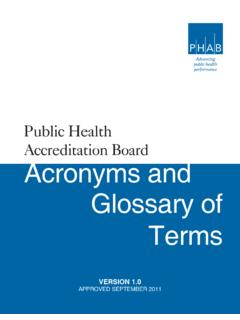Transcription of Glossary of Commonly Used Healthcare Acronyms and …
1 IDF Health Insurance Toolkit - 29 Glossary of Commonly used Healthcare Acronyms and terms Healthcare and Insurance Related Acronyms ACA: Affordable Care Act ACO: Accountable Care Organization APTC: Advanced Premium Tax Credit AV: Actuarial Value CAC: Certified Application Counselor CAP: Consumer Assistance Program CCIIO: Center for Consumer Information and Insurance Oversight CDC: Centers for Disease Control and Prevention CHC: Community Health Center CHIP: Children s Health Insurance Program CMS: Centers for Medicare & Medicaid Services COB: Coordination of Benefits COBRA: Consolidated Omnibus Budget Reconciliation Act CO-OP: Consumer Operated and Oriented Plan CSR: Cost-Sharing Reduction DME: Durable Medical Equipment ECP: Essential Community Provider EHB: Essential Health Benefits EMR: Electronic Medical Record EOB: Explanation of Benefits EPO: Exclusive Provider Organization EPSDT: Early Periodic Screening, Diagnostic & Treatment Services ERISA: Employee Retirement Income Security Act ESI: Employer-sponsored Insurance FFM/FFE: Federally Facilitated Marketplace/ Federally Facilitated Exchange FFS: Fee-for-service FPL: Federal Poverty Level FQHC: Federally Qualified Health Center FSA: Flexible Spending Account HCR: Health Care Reform HCBS: Home and Community-Based Services HHS: Department of Health and Human Services HIPAA: Health Insurance Portability and Accountability Act HIM/HIX: Health Insurance Marketplace/ Health Insurance Exchange HMO: Health Maintenance Organization HRP: High Risk Pool HRSA: Health Resources and Services Administration HSA: Health Savings Account HDHP: High Deductible Health Plan IPA: In-Person Assisters Program LTC: Long Term Care MAGI: Modified Adjusted Gross Income MA: Medicare Advantage MLR: Medical Loss Ratio OEP: Open Enrollment Period OON: Out of Network OOP.
2 Out of Pocket PBM: Pharmacy Benefit Manager IDF Health Insurance Toolkit - 30 PCIP: Pre-existing Condition Insurance Plan PCORI: Patient-Centered Outcomes Research Institute PCP: Primary Care Provider PDP: Prescription Drug Plan under Medicare Part D POS: Point-of-Service Plan PPO: Preferred Provider Organization QHP: Qualified Health Plan SBC: Summary of Benefits and Coverage SBM/SBE: State Based Marketplace/State Based Exchange SEP: Special Enrollment Period SHOP: Small Business Health Options Program SNF: Skilled Nursing Facility SPM/SPE: State Partnership Marketplace/ State Partnership Exchange SPP: Specialty Pharmacy Provider SSDI: Social Security Disability Income SSI: Supplemental Security Income TPA: Third Party Administrator UCR: Usual, Customary and Reasonable Charges Glossary of Commonly used Healthcare terms 340B Program: The 340B Drug Pricing Program enables eligible health care organizations (known as covered entities) to purchase drugs from manufacturers at reduced prices.
3 It is called 340B since that is the section of the Public Health Service Act that establishes the program. Accountable Care Organization (ACO): A group of Healthcare providers that gives coordinated care for chronic disease management with the goal of improving the quality of patient care. The organization s payment is tied to achieving Healthcare quality goals and outcomes that result in cost savings. ACOs can include various types of doctors primary care, specialists, etc. as well as other medical providers (nurses, physician s assistants, etc.) and institutions (hospitals, multi-physician practices). Accreditation: If a health plan provided in the Marketplace/Exchange is approved, this is the seal of approval given to the plan by an independent organization to show that the plan meets national quality standards. Actuarial Value (AV): The percentage of total average costs for covered benefits that a plan will cover.
4 Example: if a plan has an actuarial value of 70%, on average you would be responsible for 30% of the costs of all covered benefits. However, you could be responsible for a higher or lower percentage of the total costs of covered services for the year, depending on your actual Healthcare needs and the terms of your insurance policy. Under the Affordable Care Act, four health plan categories, Bronze, Silver, Gold and Platinum, (sometimes called metal tiers) will be offered in the Marketplaces/Exchanges. The tiers are based on the actuarial value of providing essential health benefits to members. While two plans may be in the same metal tier, that does not mean that they will cover the same benefits in the same way - the percentages are set over the entire plan and not any individual service. (See Bronze, Silver, Gold and Platinum Health Plans and Fact Sheet). Advanced Premium Tax Credit (APTC): Also referred to as a premium tax credit, this new tax credit provided for in the Affordable Care Act helps make coverage purchased in the Marketplace/Exchanges more affordable for consumers.
5 Advance payments of the tax credit can be used right away to lower monthly premium costs. Qualified consumers may choose how much advance credit payments to apply to their premiums each month, up to a maximum amount. If the amount of advance credit payments a consumer gets for the year is less than the tax credit due, the consumer will get the difference as a refundable credit when they file their federal IDF Health Insurance Toolkit - 31 income tax return. If the consumer s advance payments for the year are more than the amount of their credit, they must repay the excess advance payments with their tax return. Affordable Care Act (ACA): Also known as the Patient Protection and Affordable Care Act (PPACA), health care reform (HCR) and Obamacare, it is the comprehensive Healthcare reform law enacted in March 2010. The law was enacted in two parts: PPACA was signed into law on March 23, 2010. It was amended by the Health Care and Education Reconciliation Act on March 30, 2010.
6 Affordable Care Act refers to the final, amended version of the law. Affordable Coverage (as it relates to the APTC): Employer coverage is considered affordable - as it relates to the Advanced Premium Tax Credit (APTC) - if the employee s share of the annual premium for self-only coverage is no greater than of annual household income. Starting in 2014, individuals offered employer-sponsored coverage that s affordable and provides minimum value will not be eligible for a premium tax credit if they choose to purchase health insurance in the Marketplace. Allowed Amount: Discounted fees that insurers will recognize and pay for covered services. Insurers negotiate these discounts with providers in their health plan network. Network providers agree to accept the allowed charge as payment in full. Each insurer has its own schedule of allowed charges. Annual Limit: A cap on the benefits your insurance company will pay in a year while you are enrolled in a health insurance plan.
7 Annual caps are sometimes placed on particular services such as prescriptions or hospitalizations. Annual limits may be placed on the dollar amount of covered services or on the number of visits for a particular service. After the annual limit is reached, you must pay all associated Healthcare costs for the rest of the year. Appeal: A request for a health insurer or plan to review a decision or a grievance again. Balance Billing: The practice of billing a patient for charges not paid by his/her insurance plan because the charges exceed covered amounts. Balance billing amounts will often be charges that are above the usual and customary rates. Benefits: The Healthcare items or services covered under a health insurance plan. Covered benefits and excluded services are defined in the health insurance plan s coverage documents. In Medicaid or CHIP, covered benefits and excluded services are defined in state program rules.
8 Biologic: A biologic (also known as a biological product) is a type of complex medication such as a vaccine, blood or blood product, or other treatment that mimics proteins naturally present in the body. Rather than being created chemically like drugs, biologics are based off of recombinant, cell or tissue-based proteins. Clotting immunoglobulin replacement therapy is a biologic. Biosimilar Biological Products: A biosimilar is the follow-on or subsequent version of a biologic. Biosimilars and biologic products have the same relationship that generic drugs have with brand name drugs, with an important distinction that due to their complexity, biosimilars are not identical to the original biologic product. Bronze Health Plan: A plan in the health insurance Marketplace/Exchanges where the percentage the plan pays of the average overall cost of providing essential health benefits to members is 60%. Care Coordination: The process of organizing your treatment across several Healthcare providers.
9 Medical homes and Accountable Care Organizations (see definition) are two common ways to coordinate care. Catastrophic Plan: A Healthcare plan that only covers certain types of expensive care, like hospitalizations. May also include plans that have a high deductible, so that your plan begins to pay only after you ve first paid IDF Health Insurance Toolkit - 32 up to a certain amount for covered services. You must be under 30 years old to purchase a catastrophic plan through a Marketplace/Exchange. Center for Consumer Information and Insurance Oversight (CCIIO): Located within the Centers for Medicare & Medicaid Services (part of the Department of Health & Human Services), the Center is the federal agency tasked with implementing many provisions of the Affordable Care Act related to private health insurance. Centers for Disease Control and Prevention (CDC): The federal agency responsible for protecting health and promoting quality of life through the prevention and control of disease, injury, and disability.
10 Centers for Medicare and Medicaid Services (CMS): The federal agency that administers the Medicare, Medicaid, and Children s Health Insurance Programs, and implements many provisions of the Affordable Care Act related to private health insurance Marketplaces/Exchanges. Certified Application Counselor (CAC): An individual (affiliated with a designated organization) who is trained to help consumers, small businesses, and their employees as they search for and enroll in health insurance options through the Marketplace/Exchanges created by the ACA. CAC services are free to consumers. (See Fact Sheet). Children s Health Insurance Program (CHIP): Insurance program jointly funded by state and federal government that provides health insurance to low-income children. In some states, it covers pregnant women in families who earn too much income to qualify for Medicaid but cannot afford to purchase private health insurance coverage.







